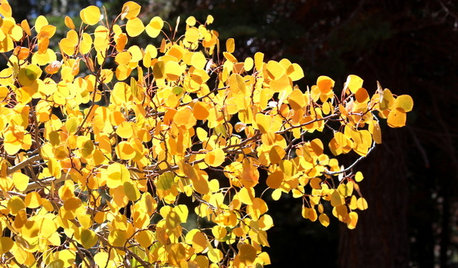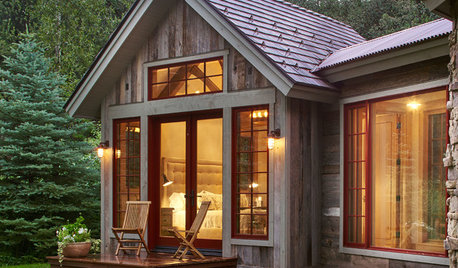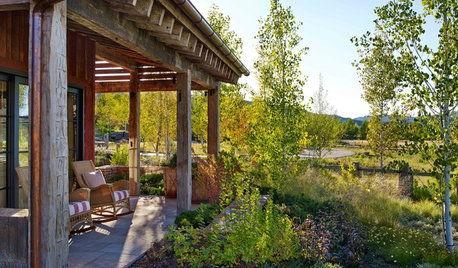newly transplanted Aspen trees
jeanenem
13 years ago
Featured Answer
Sort by:Oldest
Comments (43)
musicalperson
13 years agolast modified: 9 years agobrandon7 TN_zone7
13 years agolast modified: 9 years agoRelated Discussions
Crabgrass killer around newly transplanted trees?
Comments (4)Yes, you can still apply. Given the extra rapid warmup, you may have missed some seeds, but once crabgrass gets started, there are multiple generations most years. Or more accurately, multiple cycles of seed production. so you'll still be doing some good. True story: I once hand weeded the crab grass out of my yard. I actually let it get nice and full grown-more of a handle that way- and went out after a soaking rain and just started pulling. It comes out real nice! +oM...See MoreTransplanting Aspens
Comments (2)Were you able to preserve a basketball sized rootball when you dug each of them up? Did you keep the rootball moist from the time you dug up till to time you planted? I've been transplanting some aspen in Castle Rock at el. 6500' and haven't lost any yet. They seemed rather easy to plant, with such minimal roots and shallow holes. These were bought from a local seller, but planted by myself. The place selling them, was in Parker near Lowes on Dransfelt & Longs. I had amended my soil with (HD) mushroom compost and mixed it into the backfill pretty well. I also had good compost to mix in as well. No more than 25% amended. Make sure not to plant them low (below ground level). Rather be 1" high than 1" low. Sounds like you did a lot right. Did you get the trees from a substantially different elevation? Did you wrap the trees when delivering them down from the mountains to your yard? They really won't like being thrown in a pickup and then doing 70 for an hour ... that can kill them. You need to wrap in plastic or a tarp, protect from the wind from the trip and drive slower....See MoreNeed help with newly transplanted Redbud Tree
Comments (4)If you are pretty positive they are dead, I would trim them now - if, heaven forbid, you should damage one of the "replacements" then a new one will have time to grow. Just be really careful not to damage them as you cut out the old one(s). I would select the strongest 3-4 of the new sprouts, and about mid-summer, take out the weakest one(s), as low down as possible, so you will end up with the number of trunks you want. You may have to repeat for a few years, until it settles down as a multi-trunked tree, or it may be an annual chore. My two (a species and a 'Forest Pansy") are single trunked, and I haven't noticed many sprouts - they are most easily removed when tiny, simply by rubbing them off the bark....See More?? transplanting Quacking Aspen
Comments (5)That's what I need, a quacking aspen, the perfect cultivar for my swamp arboretum! It will run around the yard eating slugs, lots of fat slimy slugs, while fluttering in the breeze. It will happily paddle in all the winter water and quack welcomes to other aspens and ducks. All the ducks and quacking aspens will eat slugs, zillions of slugs, and grow strong and tall and richly verdant. The quacking aspens will congregate into a lush grove and no slugs will be seen for miles forevermore. Please send me some of these! I will pay you a handsome price!...See Morejeanenem
13 years agolast modified: 9 years agosalicaceae
13 years agolast modified: 9 years agojeanenem
13 years agolast modified: 9 years agosalicaceae
13 years agolast modified: 9 years agojeanenem
13 years agolast modified: 9 years agojeanenem
13 years agolast modified: 9 years agorhizo_1 (North AL) zone 7
13 years agolast modified: 9 years agobrandon7 TN_zone7
13 years agolast modified: 9 years agoken_adrian Adrian MI cold Z5
13 years agolast modified: 9 years agomusicalperson
13 years agolast modified: 9 years agobrandon7 TN_zone7
13 years agolast modified: 9 years agosalicaceae
13 years agolast modified: 9 years agomusicalperson
13 years agolast modified: 9 years agojeanenem
13 years agolast modified: 9 years agomusicalperson
13 years agolast modified: 9 years agov1rt
13 years agolast modified: 9 years agoDan _Staley (5b Sunset 2B AHS 7)
13 years agolast modified: 9 years agosalicaceae
13 years agolast modified: 9 years agobrandon7 TN_zone7
13 years agolast modified: 9 years agobrandon7 TN_zone7
13 years agolast modified: 9 years agoDan _Staley (5b Sunset 2B AHS 7)
13 years agolast modified: 9 years agojeanenem
13 years agolast modified: 9 years agoDan _Staley (5b Sunset 2B AHS 7)
13 years agolast modified: 9 years agosalicaceae
13 years agolast modified: 9 years agojeanenem
13 years agolast modified: 9 years agobrandon7 TN_zone7
13 years agolast modified: 9 years agorhizo_1 (North AL) zone 7
13 years agolast modified: 9 years agojeanenem
13 years agolast modified: 9 years agobrandon7 TN_zone7
13 years agolast modified: 9 years agoDan _Staley (5b Sunset 2B AHS 7)
13 years agolast modified: 9 years agosalicaceae
13 years agolast modified: 9 years agokrycek1984
13 years agolast modified: 9 years agobrandon7 TN_zone7
13 years agolast modified: 9 years agokrycek1984
13 years agolast modified: 9 years agosalicaceae
13 years agolast modified: 9 years agokrycek1984
13 years agolast modified: 9 years agoDan _Staley (5b Sunset 2B AHS 7)
13 years agolast modified: 9 years agokrycek1984
13 years agolast modified: 9 years agoCarolina
8 years agoChris Healy
3 years ago
Related Stories

LANDSCAPE DESIGNGreat Design Plant: Quaking Aspen for 3-Season Beauty — on Its Own Turf
It offers bright fall foliage, snowy winter bark and lush green leaves in summer. Just don't try to plant quaking aspen away from its home
Full Story
GUESTHOUSESHouzz Tour: A River (Almost) Runs Through It in Aspen
This guesthouse on a family compound has rustic charm, modern touches and dramatic river views
Full Story
FALL GARDENING6 Trees You'll Fall For
Don’t put down that spade! Autumn is the perfect time for planting these trees
Full Story
LANDSCAPE DESIGNThe Unparalleled Power of Trees
Discover the beauty and magic of trees, and why a landscape without them just isn't the same
Full Story
TREESHow to Buy Healthy Trees and Shrubs
A healthy young plant with a strong form is more likely to do well in your yard. Here’s what to look for at the nursery
Full Story
SIDE YARD IDEASNarrow Trees for Tight Garden Spaces
Boost interest in a side yard or another space-challenged area with the fragrance and color of these columnar trees
Full Story
FALL GARDENING11 Trees for Brilliant Fall Color
Give your landscape the quintessential look of autumn with the red, orange and yellow leaves of these standouts
Full Story
GARDENING GUIDESPlant Black Cherry Trees for the Birds and Bees
Plant Prunus serotina in the Central and Eastern U.S. for spring flowers, interesting bark and beautiful fall color
Full Story
EVENTSSee 5 Colorado Landscapes That Blend Nature With Artistry
These Denver and Aspen gardens — part of the Cultural Landscape Foundation’s Garden Dialogues series — embrace their larger environments
Full Story
HOUZZ TOURSMy Houzz: A Dallas Family Home Freshens Up
With its newly open interior and thoughtfully collected art, this home bridges contemporary and eclectic with flair
Full Story







jeanenemOriginal Author